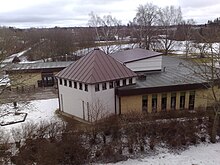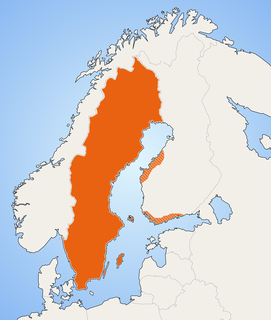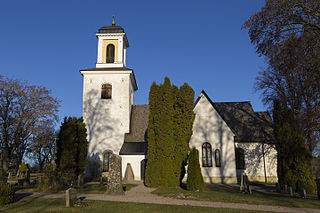Coordinates: 59°51′57.6″N17°41′8.1″E / 59.866000°N 17.685583°E

A geographic coordinate system is a coordinate system that enables every location on Earth to be specified by a set of numbers, letters or symbols. The coordinates are often chosen such that one of the numbers represents a vertical position and two or three of the numbers represent a horizontal position; alternatively, a geographic position may be expressed in a combined three-dimensional Cartesian vector. A common choice of coordinates is latitude, longitude and elevation. To specify a location on a plane requires a map projection.
| Årsta Church | |
|---|---|
 | |
| Basic information | |
| Location | Årsta, Uppsala, Sweden |
| Affiliation | Church of Sweden |
| State | Sweden |
| Province | Vaksala parish, Archdiocese of Uppsala |
| Region | Uppsala County |
| Status | Active |
| Website | www |
| Architectural description | |
| Architect(s) | Samuel Fränne |
| Architectural type | Church |
| Completed | 1974 |
Årsta Church (Swedish : Årstakyrkan) is a church in Årsta, Uppsala, Sweden that was built in 1974, and was designed by Samuel Fränne. The church was originally owned by the Uppsala Missionary Congregation, but is now a district church in Vaksala parish. It has an ecumenical cooperation with the Swedish Salvation Army. [1]

Swedish is a North Germanic language spoken natively by 10 million people, predominantly in Sweden, and in parts of Finland, where it has equal legal standing with Finnish. It is largely mutually intelligible with Norwegian and to some extent with Danish, although the degree of mutual intelligibility is largely dependent on the dialect and accent of the speaker. Both Norwegian and Danish are generally easier for Swedish speakers to read than to listen to because of difference in accent and tone when speaking. Swedish is a descendant of Old Norse, the common language of the Germanic peoples living in Scandinavia during the Viking Era. It has the most speakers of the North Germanic languages.

Uppsala is the capital of Uppsala County and the fourth-largest city in Sweden, after Stockholm, Gothenburg, and Malmö. It had 168,096 inhabitants in 2017.

Sweden, officially the Kingdom of Sweden, is a Scandinavian Nordic country in Northern Europe. It borders Norway to the west and north and Finland to the east, and is connected to Denmark in the southwest by a bridge-tunnel across the Öresund, a strait at the Swedish-Danish border. At 450,295 square kilometres (173,860 sq mi), Sweden is the largest country in Northern Europe, the third-largest country in the European Union and the fifth largest country in Europe by area. Sweden has a total population of 10.2 million of which 2.4 million has a foreign background. It has a low population density of 22 inhabitants per square kilometre (57/sq mi). The highest concentration is in the southern half of the country.
The church also runs a pre-school for children who are 0–5 years old. [2]

A preschool, also known as nursery school, pre-primary school, playschool or kindergarten, is an educational establishment or learning space offering early childhood education to children before they begin compulsory education at primary school. It may be publicly or privately operated, and may be subsidized from public funds.





















